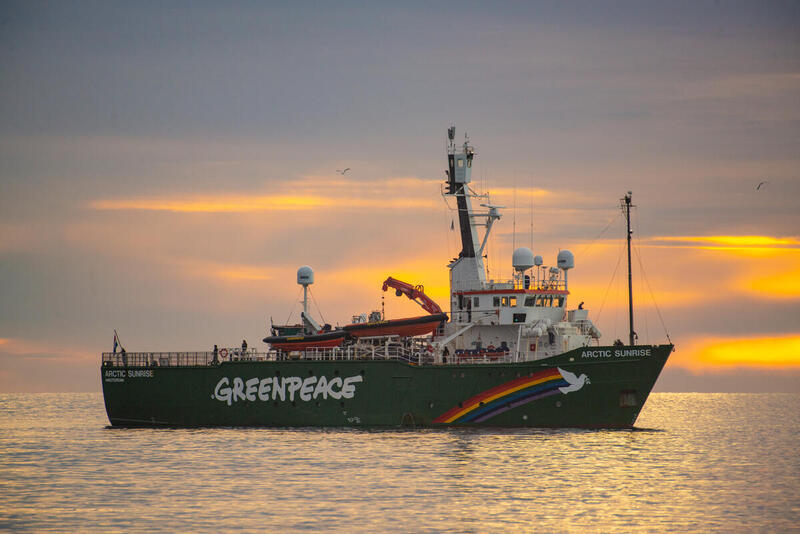Greenpeace Ship To Visit Bermuda In May
The Greenpeace ship Arctic Sunrise will visit Bermuda in May, and “will make several forays into the Sargasso Sea outside Bermuda’s national waters to conduct scientific research and to document the wildlife living there.”
A spokesperson said, “The Greenpeace ship Arctic Sunrise is visiting Bermuda from May 5 to May 21 as part of a global initiative to promote the Global Ocean Treaty [High Seas Treaty] and to call for the creation of a high seas ocean sanctuary on the Sargasso Sea.
“The vessel will be docked in Hamilton and will make several forays into the Sargasso Sea outside Bermuda’s national waters to conduct scientific research and to document the wildlife living there. The Greenpeace team is also hoping to meet and speak with Bermudians at a series of events to gather feedback and raise awareness of marine conservation:
- “Sea Scholars [May 7]: Bermudian students will be invited aboard the Arctic Sunrise for educational visits, offering them the chance to learn about marine conservation efforts firsthand from environmental activists.
- “Nonsuch Island Green-Up Day [May 11]: A clean-up event on Nonsuch Island in collaboration with Keep Bermuda Beautiful to highlight the issue of marine litter and its impact on ecosystems.
- “Open Boat Day [May 18]: The Arctic Sunrise will open its doors to the public, providing a unique glimpse of life onboard one of Greenpeace’s iconic ships.
- “Blue Boundaries Workshop [May 20]: A high-level workshop with representatives of the Bermudian government, Sargasso Sea Commission and others to discuss the creation of a high seas ocean sanctuary on the Sargasso Sea as part of a global network of protected areas.
“The timing of the visit is significant as it follows the signing of the Global Ocean Treaty at the UN last September. This historic agreement provides a tool to create sanctuaries on the high seas – the international waters that make up more than 60% of the world’s ocean. Part of the Sargasso Sea falls within Bermudian waters, but most of it lies in the high seas and is not protected. Scientists have identified the Sargasso Sea as a priority area to be protected under the Treaty.”
Briony Venn, senior oceans campaigner for Greenpeace UK, said, “The Sargasso Sea contains a golden floating rainforest of Sargassum seaweed that supports a plethora of iconic but highly threatened species, including Bermuda’s national bird – the Cahow. Sadly it also faces many threats – from industrial fishing by international fleets to plastic pollution and climate change. We’re super excited to be spending two weeks in Bermuda joining forces with the community, scientists and leaders in calling for better protection.”
Bermudian sustainability solutionist Noelle Young, who is advising Greenpeace during their stay said, “My goal is to foster intergenerational, cooperative dialogue focused on sustainable environmental stewardship and the preservation of our island and its culture for future generations. Greenpeace’s focus is on the international waters that surround us but are beyond Bermuda’s control. This is precisely why I feel it’s crucial for Bermudians to lead in designing an ocean sanctuary in the Sargasso Sea.”
The spokesperson said, “Bermudian ornithologists Erich Hetzel and Paul Watson will be joining the Arctic Sunrise to conduct a seabird survey on its transit into Bermuda from the Bahamas.
“Greenpeace last visited Bermuda in 2019 with its ship Esperanza as part of a Pole to Pole expedition highlighting threats to the ocean. On that trip, scientists studied the impact of plastics and microplastics on marine life in the Sargasso and the importance that drifting Sargassum seaweed has for the development of juvenile sea turtles. They found concentrations of microplastics that were higher than those found in the Great Pacific Garbage Patch.”
Read More About
Category: All, Environment, News





On a ship powered by evil fossil fuels – go figure.
Say, what does Greenpeace have to say about Bermuda’s proposed bird-chopping wind farm? Perhaps all that bird chum is good for the fish?